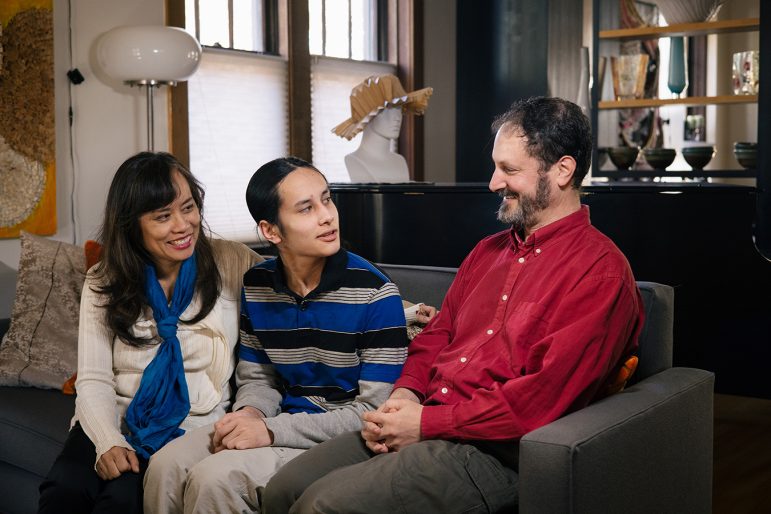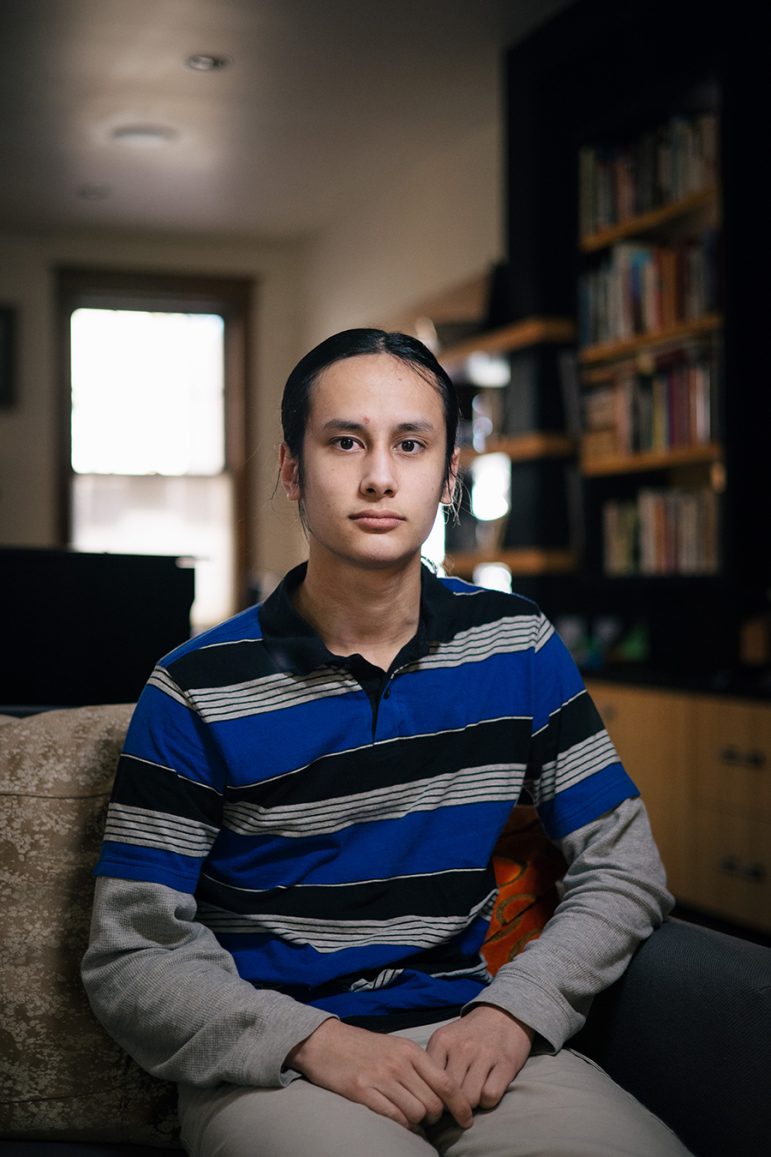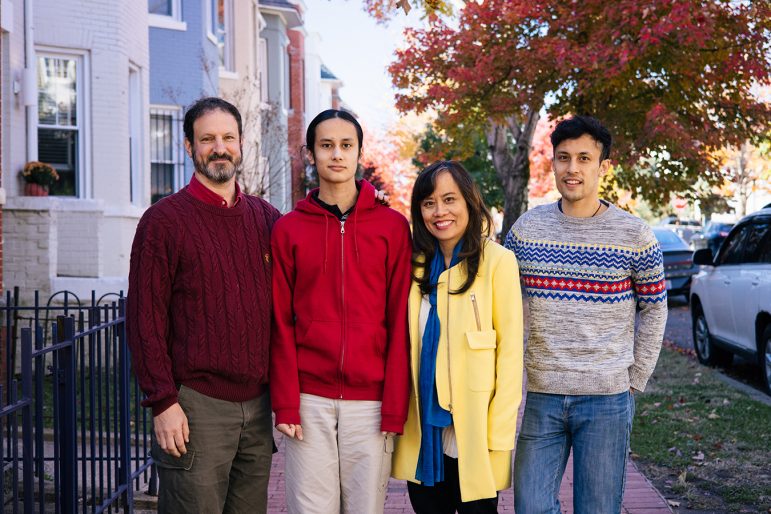Alexander Roodman was packing up his room, preparing for a gap year before college, when I met him at his family’s Washington, D.C., townhouse.
The room was a typical teenage disaster zone, with clothes and books strewn everywhere.
Then, Alex picked up an origami sculpture that rippled with dozens of ridges and depressions. “It’s kind of a repetitive pattern,” he said. “First, you make the diagonal folds and these lateral folds to cut the paper in half.”
It’s pretty complicated. Alex, a slim teenager with long black hair and penetrating eyes, is gifted with the focus for this. But the way his brain works can be a challenge.
Alex is autistic.
And like many parents of children with autism, Alex’s mother and father have spent years trying to find a doctor or school or therapist who could help.
“I think he always believed we were on his side. But he could also see that we were sometimes helpless,” said Dr. Mai Pham, Alex’s mother. “It’s a little bit like hot potato. Is the school supposed to counsel me? Is the pediatrician supposed to counsel me? … Am I supposed to figure that out?”
The U.S. has made major strides in recent decades in raising awareness about autism and other intellectual and developmental disabilities, which affect as many as 1 in 20 Americans.
Improvements in screening, new therapies, and burgeoning specialty clinics have made available care that was unthinkable a generation ago. But the health care system is still failing millions of Americans from the time they are children, experts and advocates say.

When Alex was born, this world and its frustrations were an abstraction for Pham and her husband, David Roodman, a Harvard-trained policy analyst.
There were signs their second child was a little different. Pham remembers taking Alex on a trip when he was 3 months old.
“In a hotel room in Miami, we put him on the floor thinking, ‘OK, we have five minutes now before the baby acts up,’” Pham said. “He actually spent 20 minutes being nearly still, just his eyes tracking the shadows of a palm frond on the walls.”
In preschool, Alex had difficulty connecting with other kids and sometimes became agitated when classmates didn’t seem interested in what he wanted to talk about.
Still, Pham and Roodman were assured by their pediatrician and others that there was no cause for alarm. Even when a school assessment established that Alex was autistic, Pham and Roodman received few warnings about the challenges ahead.
As Alex got older, he attended a private middle school that specializes in working with students like him. He did well, according to his parents.
The transition to high school proved more difficult, however. Although a gifted math student, Alex increasingly struggled with subjects like English and history that require explaining the perspective of others.
His autism fueled crippling anxiety. Alex had trouble sleeping and picked at his hands until they bled. There were frequent breakdowns.
“He might slam the wall with things. … He broke the tip off a knife,” Pham said. “He always felt contrite afterward. He just didn’t have any other avenue for, you know, adequately expressing how frustrated he was.”
Pham thought she’d be better prepared than most parents to find help. She’s an internist and former senior Medicare and Medicaid official with degrees from Harvard and Johns Hopkins.
Pham scrambled to find help, tapping a wide social and professional network around Washington, D.C. The metropolitan area boasts the highest concentration of child and adolescent psychiatrists in the country, 10 times the level in some rural parts of the country, according to one analysis.
Yet, as Alex struggled, Pham said, their family was lost. Time and again, pediatricians, psychiatrists, and therapists minimized Alex’s symptoms or shuffled him to someone else.

That’s a common experience, said Monica Adler Werner, a counselor who works with patients with autism around Washington, D.C. “The odyssey that parents have to go on in order to find what their children need is really a shame of our society,” she said.
Long waitlists for therapy remain the norm nationwide. So are medical bills that can reach tens of thousands of dollars.
“We were lucky we could afford those services,” Pham said. “We have health insurance. … I had the kind of jobs where I could hop in the car once or twice a week and drive 50 minutes each way to get him to therapy.”
Millions of Americans face even bigger barriers to care. Families in rural areas often travel hours for services. Many Black and Hispanic families face persistent inequities in the U.S. health care system.
Nationally, parents of children with autism are 10 times as likely to say they’re “usually or always” frustrated in their efforts to get services.
Primary care physicians — a convenient option for many families — could fill some of those gaps if the doctors had better training, said Dr. Kristin Sohl, a pediatrician who teaches these skills at the University of Missouri. “We’ve got to make this accessible so that people can have access to what they need when and where they need it,” Sohl said.
But many physicians feel ill equipped to provide this care.
In one survey, just 40% said they were very confident that their care for patients with disabilities was as good as for other patients. Only about half strongly agreed that they welcome patients with a disability.
Training remains one barrier. Even though as many as 16 million Americans have autism or another intellectual or developmental disability, the subject is a small part of the curriculum at most medical schools.
Another obstacle, Sohl and others say, is a tendency in American health care to simply refer patients to specialists. “It’s so hierarchical,” Sohl said.
Changing that has become Mai Pham’s life’s work.
She quit her job at a major health insurer in 2020 to start Institute for Exceptional Care. The nonprofit aims to overhaul the way doctors are trained and paid so they can spend more time with patients with disabilities, instead of rushing through visits because of billing pressures.

“We’ve made huge investments in the science and in some ways the clinical aspects of care,” Pham said. “But we haven’t thought about how to make any of that sustainable.”
Pham said that is particularly important because so many patients are aging — and developing medical conditions such as diabetes, heart disease, and dementia.
“How you communicate to someone like my son or how you manage chronic conditions for him will need to be different,” Pham said. “The health system hasn’t thought about that.”
Help for Alex ultimately came from a specialist. Adler Werner, whom Pham found through friends, became what Pham described as an “autism coach,” helping the family understand what Alex was experiencing.

Adler Werner, now a cognitive behavioral therapist, focused on empowering Alex so he could appreciate his strengths and develop tools to navigate challenging tasks like communicating verbally and managing stress.
“What we want to be doing is working with young people to allow them to understand their differences, accept and own them, not have them be seen … as character flaws,” Adler Werner explained. “Alexander is really extraordinary and unbelievably interesting.”
I caught up with Alex not long ago in Vermont. He’s at a program that helps teenagers like him develop skills to live independently. He’s taking math at the University of Vermont. He’s been rock climbing and hiking with classmates in the Green Mountains.
Alex said he’s been enjoying himself. “I’m learning about muscles I never knew I had,” he said.
Pham and her husband have been cheered by his progress. But they still worry about what’s ahead for Alex in a health care system that’s unprepared for him.
Editor’s note: KHN aims to use “person-first” language regarding people with autism – describing what they have and not what they are — except when a preference for “identity-first” language is known, such as “he is autistic.” This article reflects that nuance and respects the wishes of the family profiled.
